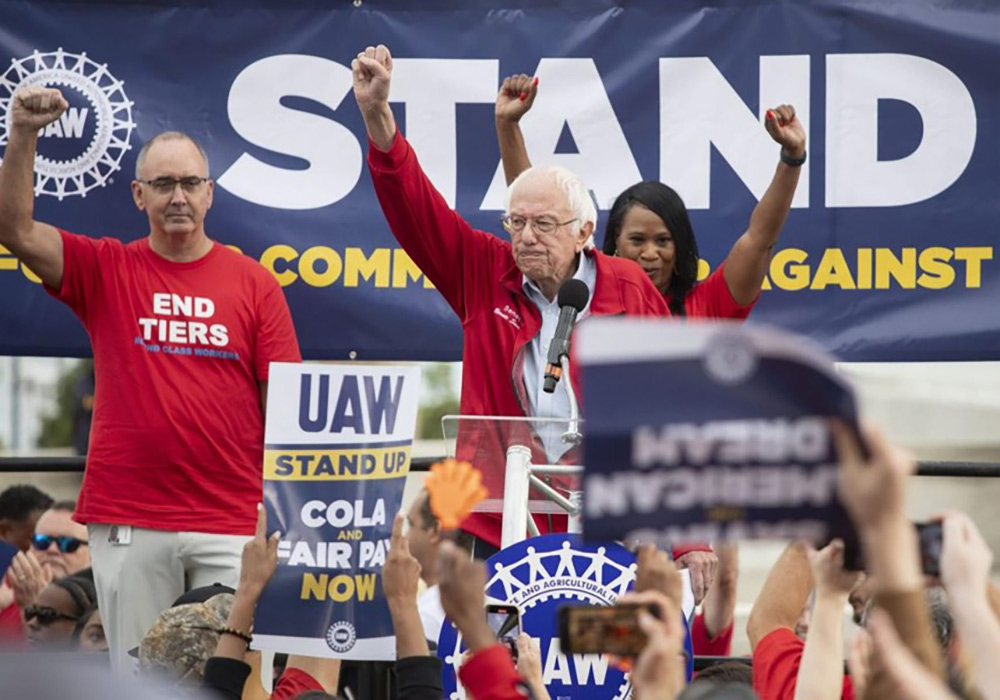
这场历史性的汽车工人罢工潮涉及底特律三大汽车制造商——通用汽车(General Motors)、斯泰兰蒂斯集团(Stellantis)和福特(Ford)。站在罢工最前线的是美国汽车工人联合会主席肖恩·费恩,他经常穿着一件写着“吞噬富人”的T恤。费恩毫不讳言他对超级富豪的看法。“在我看来,亿万富翁就没有存在的权利。”费恩上个月说,他将佛蒙特州参议员伯尼·桑德斯(左翼煽动者)最钟爱的理论带到了劳工运动前沿。
多年来,这位进步的议员一直在表达他的观点,“就不应该有亿万富翁”,并将其作为他两次总统竞选的核心内容,甚至提议征收财富税来淘汰亿万富翁。费恩反亿万富翁的言论是桑德斯论点的合乎逻辑的延伸。这一言论已成为正在进行的汽车罢工的核心。
正如桑德斯的大胆竞选主张(对富人增税与大幅增加联邦开支)颠覆了民主党数十年来关于选民能够接受的信息类型的传统思想,更不用说其关于团结支持的传统思想了,费恩毫不掩饰的反亿万富翁情绪标志着美国劳工运动进入了一个新时代。几十年来,美国劳工运动从未如此激进过。
“亿万富翁的存在向我们表明,我们的经济是为少数人而不是多数人的利益服务的。”费恩在8月底对美国汽车工人联合会成员表示。“我说,低工资和长时间工作也是如此。我们需要消灭这一切。”
恰好,费恩和桑德斯最近有了交集。在9月15日,桑德斯参加了美国汽车工人联合会的集会和游行。约4万名参加罢工的汽车工会工人要求在四年的合同期内加薪近40%,以弥补多年通货膨胀带来的生活压力,并提供其他福利。
汽车制造商试图将工人的工资要求描述为不切实际,美国汽车工人联合会以三大汽车公司首席执行官的工资为例,对此予以回击。三大汽车公司首席执行官的薪酬是普通工人薪酬的数百倍(也是欧洲汽车制造商首席执行官薪酬的数倍)。
当福特首席执行官吉姆·法利(Jim Farley)告诉美国全国广播公司财经频道(CNBC),公司“不可能”满足美国汽车工人联合会的要求时,美国汽车工人联合会在X平台上反驳道:“这个人去年赚了2100万美元。”根据美国证券交易委员会(SEC)的文件,2022年,福特员工的收入中位数不到7.5万美元,而法利的收入相当于281名福特员工的收入。
至少有一位分析师站在美国汽车工人联合会一边,摩根士丹利(Morgan Stanley)在一份报告中表示,汽车制造商很可能负担得起工会提出的加薪36%的要求——费恩本人也称这一要求“大胆”。
自从五周前罢工开始以来,一些人担心长期停工会对经济造成影响,商业圆桌会议(Business Roundtable)表示"深感担忧"。但费恩把责任推给了汽车制造商,暗示三巨头的高层蒙受的损失最大。
“这并不是说我们会破坏经济,而是我们会破坏他们的经济,这种经济只为亿万富翁阶层服务,而不是为工人阶级服务。”费恩在9月份对美国有线电视新闻网(CNN)说道。
费恩在密歇根州韦恩市的福特工厂外对媒体说:“有亿万富翁阶层,也有我们这些普通人。他们希望我们袖手旁观,靠残羹剩饭勉强度日,过着月光族的生活。我们是二等公民。”
桑德斯在美国汽车工人联合会罢工中发挥的作用
桑德斯多年来一直在说着同样的套话。长期以来,这位参议员一直鼓吹对美国社会中最富有的阶层大幅增加税收。在2019年竞选民主党总统候选人提名期间,他提出了一项税收计划,最终将消灭亿万富豪阶层,并将他们的财富重新分配给工人阶级。
在今年5月接受HBO Max的一档名为《谁在和克里斯·华莱士谈话》(Who's Talking to Chris Wallace)的节目采访时,桑德斯捍卫了这一观点。
“你的意思是,一旦你的财富达到9.99亿美元,政府就应该没收剩下的所有财富?”有人问桑德斯道。
“是的。”桑德斯回答道。“你可能不同意我的观点,但我认为人们可以靠9.99亿美元过活。我认为他们可以过上舒适生活。”
他说:" [少数]人拥有比美国社会最底层的50%的人更多的财富,如果这样的现象不复存在,经济会充满活力。"他还补充说,如果按照他的意愿来执行,那么那些“赚得盆满钵满”的人将不得不“支付一大笔钱”。
福特和通用汽车已经感受到为期五周的罢工带来的压力。通用汽车首席财务官保罗·雅各布森(Paul Jacobson)在周二的财报电话会议上表示,罢工今年给公司造成了8亿美元的损失,此后每周还将造成2亿美元的损失。同一天,通用汽车披露本季度利润超过30亿美元,费恩的工会扩大了罢工规模,5,000名工人离开了位于德克萨斯州阿灵顿的工厂(该工厂生产通用汽车利润最高的SUV车型)。
费恩周五表示,汽车制造商已就加薪23%达成一致,但他告诉成员,“还要争取更多。”这让一些人怀疑他的“大胆”要求是否太过分了,或者他是否有计划结束罢工。
“他从公司那里得到的东西远远超出了任何人,尤其是公司所预期的。”加州大学伯克利分校专门研究劳工问题的名誉教授哈利·沙肯(Harley Shaiken)告诉美联社(Associated Press)。“但现在是关键的时刻,你要把所有计划整合在一起。如果不是现在,更待何时呢?”(财富中文网)
译者:中慧言-王芳
2023年9月15日,参议员伯尼·桑德斯(Bernie Sanders)和美国汽车工人联合会(UAW)主席肖恩·费恩(Shawn Fain,左)在密歇根州底特律举行的支持美国汽车工人联合会成员罢工的集会上发表讲话(罢工潮涉及底特律三大汽车制造商)。
这场历史性的汽车工人罢工潮涉及底特律三大汽车制造商——通用汽车(General Motors)、斯泰兰蒂斯集团(Stellantis)和福特(Ford)。站在罢工最前线的是美国汽车工人联合会主席肖恩·费恩,他经常穿着一件写着“吞噬富人”的T恤。费恩毫不讳言他对超级富豪的看法。“在我看来,亿万富翁就没有存在的权利。”费恩上个月说,他将佛蒙特州参议员伯尼·桑德斯(左翼煽动者)最钟爱的理论带到了劳工运动前沿。
多年来,这位进步的议员一直在表达他的观点,“就不应该有亿万富翁”,并将其作为他两次总统竞选的核心内容,甚至提议征收财富税来淘汰亿万富翁。费恩反亿万富翁的言论是桑德斯论点的合乎逻辑的延伸。这一言论已成为正在进行的汽车罢工的核心。
正如桑德斯的大胆竞选主张(对富人增税与大幅增加联邦开支)颠覆了民主党数十年来关于选民能够接受的信息类型的传统思想,更不用说其关于团结支持的传统思想了,费恩毫不掩饰的反亿万富翁情绪标志着美国劳工运动进入了一个新时代。几十年来,美国劳工运动从未如此激进过。
“亿万富翁的存在向我们表明,我们的经济是为少数人而不是多数人的利益服务的。”费恩在8月底对美国汽车工人联合会成员表示。“我说,低工资和长时间工作也是如此。我们需要消灭这一切。”
恰好,费恩和桑德斯最近有了交集。在9月15日,桑德斯参加了美国汽车工人联合会的集会和游行。约4万名参加罢工的汽车工会工人要求在四年的合同期内加薪近40%,以弥补多年通货膨胀带来的生活压力,并提供其他福利。
汽车制造商试图将工人的工资要求描述为不切实际,美国汽车工人联合会以三大汽车公司首席执行官的工资为例,对此予以回击。三大汽车公司首席执行官的薪酬是普通工人薪酬的数百倍(也是欧洲汽车制造商首席执行官薪酬的数倍)。
当福特首席执行官吉姆·法利(Jim Farley)告诉美国全国广播公司财经频道(CNBC),公司“不可能”满足美国汽车工人联合会的要求时,美国汽车工人联合会在X平台上反驳道:“这个人去年赚了2100万美元。”根据美国证券交易委员会(SEC)的文件,2022年,福特员工的收入中位数不到7.5万美元,而法利的收入相当于281名福特员工的收入。
至少有一位分析师站在美国汽车工人联合会一边,摩根士丹利(Morgan Stanley)在一份报告中表示,汽车制造商很可能负担得起工会提出的加薪36%的要求——费恩本人也称这一要求“大胆”。
自从五周前罢工开始以来,一些人担心长期停工会对经济造成影响,商业圆桌会议(Business Roundtable)表示"深感担忧"。但费恩把责任推给了汽车制造商,暗示三巨头的高层蒙受的损失最大。
“这并不是说我们会破坏经济,而是我们会破坏他们的经济,这种经济只为亿万富翁阶层服务,而不是为工人阶级服务。”费恩在9月份对美国有线电视新闻网(CNN)说道。
费恩在密歇根州韦恩市的福特工厂外对媒体说:“有亿万富翁阶层,也有我们这些普通人。他们希望我们袖手旁观,靠残羹剩饭勉强度日,过着月光族的生活。我们是二等公民。”
桑德斯在美国汽车工人联合会罢工中发挥的作用
桑德斯多年来一直在说着同样的套话。长期以来,这位参议员一直鼓吹对美国社会中最富有的阶层大幅增加税收。在2019年竞选民主党总统候选人提名期间,他提出了一项税收计划,最终将消灭亿万富豪阶层,并将他们的财富重新分配给工人阶级。
在今年5月接受HBO Max的一档名为《谁在和克里斯·华莱士谈话》(Who's Talking to Chris Wallace)的节目采访时,桑德斯捍卫了这一观点。
“你的意思是,一旦你的财富达到9.99亿美元,政府就应该没收剩下的所有财富?”有人问桑德斯道。
“是的。”桑德斯回答道。“你可能不同意我的观点,但我认为人们可以靠9.99亿美元过活。我认为他们可以过上舒适生活。”
他说:" [少数]人拥有比美国社会最底层的50%的人更多的财富,如果这样的现象不复存在,经济会充满活力。"他还补充说,如果按照他的意愿来执行,那么那些“赚得盆满钵满”的人将不得不“支付一大笔钱”。
福特和通用汽车已经感受到为期五周的罢工带来的压力。通用汽车首席财务官保罗·雅各布森(Paul Jacobson)在周二的财报电话会议上表示,罢工今年给公司造成了8亿美元的损失,此后每周还将造成2亿美元的损失。同一天,通用汽车披露本季度利润超过30亿美元,费恩的工会扩大了罢工规模,5,000名工人离开了位于德克萨斯州阿灵顿的工厂(该工厂生产通用汽车利润最高的SUV车型)。
费恩周五表示,汽车制造商已就加薪23%达成一致,但他告诉成员,“还要争取更多。”这让一些人怀疑他的“大胆”要求是否太过分了,或者他是否有计划结束罢工。
“他从公司那里得到的东西远远超出了任何人,尤其是公司所预期的。”加州大学伯克利分校专门研究劳工问题的名誉教授哈利·沙肯(Harley Shaiken)告诉美联社(Associated Press)。“但现在是关键的时刻,你要把所有计划整合在一起。如果不是现在,更待何时呢?”(财富中文网)
译者:中慧言-王芳
At the forefront of the historic auto workers’ strike that’s roiling Detroit’s Big Three automakers—General Motors, Stellantis, and Ford—is United Auto Workers (UAW) president Shawn Fain, and he’s often literally wearing an “EAT THE RICH” t-shirt. Fain hasn’t been shy about voicing his opinions on the ultrawealthy. “Billionaires, in my opinion, don’t have a right to exist,” Fain said last month, and he’s bringing a favorite theory of firebrand Vermont Sen. Bernie Sanders to the forefront of the labor movement.
For years, the progressive lawmaker has been voicing his sentiment that, “There should be no billionaires,” making it the centerpiece of his two presidential campaigns and even proposing a wealth tax to make them obsolete. Fain’s anti-billionaire rhetoric is the logical extension of Sanders’ argument—and the narrative has become central to the ongoing auto strike.
Just as Sanders’ bold tax-and-spend campaign overturned decades of conventional Democratic thinking about the kinds of messages that voters could stomach, let alone rally behind, Fain’s unapologetic anti-billionaire sentiments mark a new era in the U.S. labor movement, which hasn’t been this militant in decades.
“The very existence of billionaires shows us that we have an economy that is working for the benefit of the few and not the many,” Fain told UAW members at the end of August. “I say the same is true for poverty wages and long hours. We need to wipe them out.”
Fittingly, Fain and Sanders recently crossed paths when the senator joined the UAW for a rally and march on Sept. 15. Some 40,000 striking unionized auto workers are demanding a nearly 40% pay raise over the course of a four-year contract to make up for years of inflation, as well as other benefits.
The UAW has shot down automakers’ attempts to paint workers’ wage demands as unrealistic by pointing to the salaries of the Big Three CEOs, who are paid hundreds of times the salary of their average worker (and multiple times what CEOs at European carmakers earn).
When Ford CEO Jim Farley told CNBC there was “no way” the company could meet the UAW’s demands, the union shot back on X, “This man made $21 MILLION DOLLARS last year.” In 2022, the median Ford employee made less than $75,000, while Farley took home the pay equivalent to 281 Ford workers, according to SEC filings.
At least one analyst is on the UAW’s side, with Morgan Stanley saying in a note that the automakers could likely afford the union’s demand for a 36% pay hike—something Fain himself has called “audacious.”
Since the strike began over five weeks ago, some have feared the impact that a long-lasting work stoppage could have on the economy, with the Business Roundtable saying it is “deeply concerned.” But Fain has put the responsibility on the carmakers, suggesting that it’s the top brass at the Big Three who have the most to lose.
“It’s not [that] we’ll wreck the economy. We’ll wreck their economy, the economy that only works for the billionaire class and not the working class,” Fain told CNN in September.
“There’s a billionaire class, and there’s the rest of us,” Fain told the press outside a Ford plant in Wayne, Mich. “We’re all expected to sit back and take the scraps and live paycheck to paycheck and scrape to get by. We’re second-class citizens.”
Sanders’ hand in the UAW strikes
Sanders has been saying variations of the same lines for years. The senator has long touted the idea of imposing much higher taxes on the wealthiest factions of U.S. society. During his 2019 campaign for the Democratic presidential nomination, he created a tax plan that would eventually eliminate the billionaire class and redistribute their wealth to the working class.
In a May interview with HBO Max’s Who’s Talking to Chris Wallace, Sanders aggressively defended this view.
“Are you basically saying that once you get to $999 million, the government should confiscate all the rest?” Sanders was asked
“Yeah,” Sanders responded. “You may disagree with me, but I think people can make it on $999 million. I think that they can survive just fine.”
“You can have a vibrant economy without [a handful of] people owning more wealth than the bottom half of American society,” he said, adding that, if he had his way then those making “a whole lot of money” would have to “pay a whole lot of money.”
Ford and General Motors are already feeling the pinch from the five-week strike. General Motors CFO Paul Jacobson said on Tuesday’s earnings call that the strike impacted it by $800 million this year, and are due to cost it $200 million per week after that. The same day, GM disclosed a profit of more than $3 billion for the quarter—and Fain’s union widened its strike, with 5,000 workers walking out of the Arlington, Texas, plant that makes GM’s most profitable SUV models.
Fain said on Friday that the automakers had united on a 23% wage hike but told members that “there is more to be won.” This has led some to wonder if his “audacious” demands have gone too far—or if he has a plan to bring the strikes to a close.
“He’s gotten far more from the companies than anyone, in particular the companies, may have expected,” Harley Shaiken, a professor emeritus specializing in labor at the University of California Berkeley, told the Associated Press. “But now is the critical point where you pull the package together. If it isn’t now, when will it be?”






